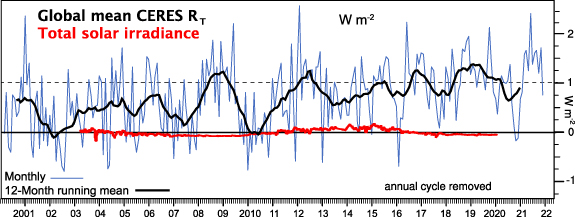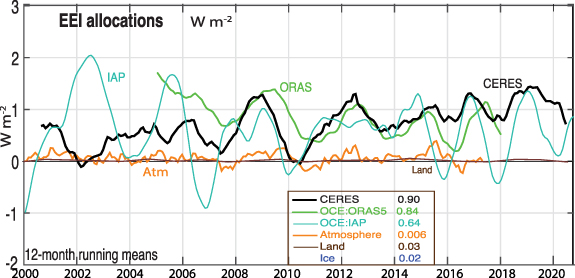8 EEI - Earth’s Energy Imbalance
Trenberth
EEI explained
The Earth is warming from human activities, primarily because of increases in carbon dioxide and other greenhouse gases (GHGs) in the atmosphere that reduce the outgoing infrared radiation from the planet escaping to space. This creates an energy imbalance at the top-of-atmosphere (TOA) called Earth’s energy imbalance (EEI). It creates heating of the planet, which is manifested in multiple ways, only one of which is the rise in global mean surface temperature GMST.
The EEI is arguably the most important metric related to climate change. It is the net result of all the processes and feedbacks in play in the climate system. However, it is also important to recognize the components of radiation at TOA, the absorbed solar radiation (ASR) and net outgoing longwave radiation (OLR). The ASR is the net incoming after reflected radiation is accounted for and varies with clouds. The net EEI is the ASR-OLR.
A key reason for this breakdown relates to proposed geoengineering, in particular, so-called solar radiation management (SRM), a euphemistic name if ever there was one. SRM alters ASR while the problem is trapping of OLR. In between are all the weather systems and hydrological cycle.
The radiative heat is variously transferred into sensible heat (related to temperatures), latent energy (related to changes in phase of water), potential energy (related to gravity and height), and kinetic energy (related to movement).
The richness of the phenomena and transformations among these various forms of energy are what makes this problem both challenging and interesting scientifically. It is not (yet) possible to measure EEI directly, although changes measured from satellites are believed to be reliable, albeit biased. The only practical way to estimate net EEI is through an inventory of the changes in energy.
Assessing EEI
In our assessment of the EEI, the focus is on the well observed period from 2005 to 2019 (see section 3). The EEI is about 460 TW or globally 0.90 ± 0.15 W \(m^−2\).
This can be compared with the net ASR and OLR of about 240 W \(m^−2\) as an estimate of the flow-through energy. Consequently, the EEI is very small and cannot be directly discerned or measured. Nevertheless, it is very large compared with estimated direct human influences such as the total electricity generated globally (about 5.7 TW in 2018)
About 93% of the extra heat from the EEI ends up in the ocean as increasing ocean heat content (OHC). On average nearly 3% of the EEI goes into melting ice and another 4% goes into raising temperatures of land and melting permafrost, while less than 1% remains in the atmosphere.
The global warming signal in OHC is large compared with the natural variability, unlike GMST, so that trends in OHC can be detected in four years. The second-best signal-to-noise ratio is in the related sea level rise (SLR), as about 40% comes from OHC and the associated expansion of the ocean, while the rest mainly comes from melting of land ice: glaciers, Greenland, Antarctica that puts more water into the ocean. For SLR the trend detection occurs in about five years while for GMST the trend detection requires more than two decades.
All components of the climate system react to heating by trying to get rid of excess heat in one way or another. The most effective method overall globally is radiative cooling as higher temperatures increase radiation by the fourth power of absolute temperature.
In the ocean, heating occurs from the top down; warm on top of colder water is a stable configuration so that the stability and stratification of the ocean increase. Whereas globally, GMST and SSTs have clearly increased since about the 1970s, for deeper ocean layers there is a delay that increases with depth. Globally, the top 500 m of the ocean are clearly warming since 1980, for 500–1000 m depth since 1990, 1000–1500 m layer since 1998, and from 1500 to 2000 m since 2005. Indeed, it is a major challenge for climate models to get this heat penetration right, since it depends on unresolved sub-grid scale processes like mixing and convection, and how well or whether tidal mixing is included. Under La Niña conditions the ocean stores extra heat, and then releases heat during El Niño events. All five oceans are warming, with the largest amounts of warming in the Atlantic Ocean and Southern Ocean surrounding Antarctica. That is a concern for Antarctica’s ice as warmer waters can creep under Antarctica’s ice shelves, thinning them and resulting in calving off huge icebergs.
EEI observations
So how well is EEI known and does it matter? Knowing how much extra energy affects weather systems and rainfall is vital to understand the increasing weather extremes. Because those weather events move energy around and help the climate system get rid of energy by radiating it to space, these processes also affect the rise in GMST. In other words, they affect the nature and magnitude of climate change, and have major implications for how well the outcomes can be modeled and predicted.
There are good estimates of TOA radiation variations from Clouds and Earth’s Radiant Energy System (CERES). The exact calibration is not well known because of questions about sampling, especially clouds, but it is thought that the changes throughout the time series are reasonably reliable.
There is an apparent trend in the CERES EEI of 0.4 W \(m^−2\) \(decade^−1\) for March 2000–December 2021. This trend is mainly due to an increase in ASR associated with decreased reflection by reduced Arctic sea-ice, and changes in clouds, reduced aerosols and increases in GHGs.

Fig: Monthly time series of CERES EBAF Ed4.1 net radiation at the TOA (positive down) relative to an estimated mean of 0.7 W \(m^−2\) for 2000–2015 (blue). The mean annual cycle is removed, and the heavy black line is the 12 month running mean (includes data through 2021). The total solar irradiance contribution is in red (updated, see Coddington et al (2016)) with the mean (1361 W \(m^−2\)) removed, and converted to a radiative forcing by dividing by 4 and multiplying by 0.7 to account for the albedo.
The Sun is often invoked as a possible source of climate change but contributions from changes in the Sun are very small. All energy from the oceans, land and ice must go through the atmosphere to reach the TOA, and the standard deviation of annual mean TOA net radiation is about three times that of the atmospheric energy tendency (figure below), highlighting that it is not atmospheric energy or temperatures so much as clouds that cause the TOA variability

Fig: Times series of 12 month running means of CERES TOA radiation (black) along with total atmospheric energy change (orange), land estimate (brown) and ocean heat content changes from two sources (green and light blue). The inset gives average values for all components including land (brown) and ice (blue) in W \(m^−2\) for 2005–2019. The thin black line is zero.
In the figure, the estimated inventory of the mean values for 2005–2019 are given. The ice time series is too small to be seen and the land values barely emerge in 2015 and 2019. Ideally, it should be possible to add up the contributions from all sources and they should agree with CERES. In the figure the agreement is reasonable from 2010 to 2016.
The ability to close the TOA energy budget beyond a long-term average is improving but remains a limitation on how well it is possible to analyze what is going on in the climate system and why. Desirably, all data should be assimilated into a comprehensive Earth system model and each component initialized, to provide the starting point for predictions. The failure and indeed inability of models to match observations in the ocean, land and ice domains demonstrates their limitations, but short-term predictions are potentially a way forward to challenge and improve both models and observations. It is vital to understand the net energy gain, and how much and where heat is redistributed within the Earth system. How much heat might be moved to where it can be purged from the Earth via radiation to limit warming? Utilizing the EEI framework, the relevant observations and their synthesis challenges models and highlights needed improvements, but with prospects for major payoffs from better information about what is going on, and why, and what the outlook is for the future.
Trenberth (2022) A perspective on climate change from Earth’s energy imbalance (pdf)